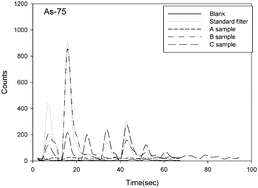In this study, we investigated the elemental contents of airborne particulate matter, having dimensions in the nanometer (<0.1 μm), submicrometer (0.1–1.0 μm), and micrometer (>1.0 μm) size ranges, collected using an electrical low-pressure impactor (ELPI). We used laser ablation/inductively coupled plasma mass spectrometry (LA-ICP-MS) to analyze the airborne particles trapped on filter media and to determine their elemental compositions. To simulate the ELPI collection of samples, we prepared laboratory-made standard filter samples by placing drops of liquid standard solutions onto the filter. The absolute limits of detection ranged from 2 × 10−2 ng for Cd to 1.06 ng for Si. The mean relative standard deviation for five replicates using the standard filter ranged from 3.5 to 17.8%. To determine the accuracy of this protocol, we analyzed the airborne particles using a standard addition method. Comparison with the data obtained using a dichotomous sampler/ICP-MS method revealed that our proposed ELPI/LA-ICP-MS method allowed the elemental and physical characteristics of ultra-fine particles in the atmosphere to be monitored with suitable accuracy to satisfy the needs of environmental, safety, and health applications.

You have access to this article
 Please wait while we load your content...
Something went wrong. Try again?
Please wait while we load your content...
Something went wrong. Try again?


 Please wait while we load your content...
Please wait while we load your content...